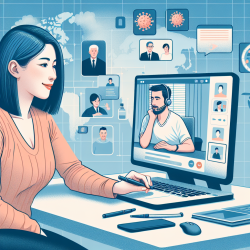Introduction
The COVID-19 pandemic has significantly transformed the landscape of healthcare, pushing the boundaries of telemedicine to the forefront. Voice therapy, a specialized field within speech-language pathology, has also embraced this shift. A recent study conducted at the USC Voice Center provides valuable insights into patient and provider satisfaction with telemedicine voice therapy during the pandemic. The study's findings highlight the efficacy and acceptance of virtual voice therapy as a viable alternative to traditional in-person sessions.
Study Overview
The study was a cross-sectional analysis involving 226 adults who received voice therapy via telepractice between April and October 2020. Satisfaction levels were measured using a visual analog scale (VAS) for both patients and providers, alongside a Telemedicine Satisfaction Questionnaire (TSQ) for patients. The results were analyzed to identify factors influencing satisfaction levels and any correlations between patient and provider satisfaction.
Key Findings
- Patient satisfaction with telemedicine voice therapy was notably high, with a mean VAS score of 86.8 out of 100.
- Provider satisfaction was slightly lower but still positive, with a mean VAS score of 80.6.
- The TSQ revealed a mean score of 4.4 out of 5, indicating strong patient satisfaction.
- Approximately 73% of patients expressed a preference for telemedicine over in-person therapy, correlating significantly with internet reliability.
Factors Influencing Satisfaction
The study identified several factors influencing satisfaction levels:
- Diagnosis Type: Patients with hypofunctional dysphonia reported higher satisfaction levels compared to those with hyperfunctional dysphonia.
- Internet Reliability: Reliable internet was crucial for higher patient satisfaction and preference for telemedicine.
- Demographics: Provider satisfaction was lower for sessions with Asian patients and for cases where the diagnosis changed after therapy initiation.
Discussion
The findings suggest that virtual voice therapy is not merely an alternative but a complementary method to in-person services. The high levels of satisfaction among patients and providers underscore the effectiveness of telepractice in delivering quality care. The preference for telemedicine, particularly among patients with reliable internet, highlights the importance of technological infrastructure in healthcare delivery.
However, the study also reveals areas for improvement. The lower provider satisfaction for sessions with Asian patients indicates a need for culturally sensitive care and better communication strategies. Additionally, ensuring accurate initial diagnoses through laryngeal imaging could enhance provider confidence and satisfaction.
Conclusion
Overall, the study supports the continued use of telemedicine for voice therapy beyond the pandemic. By addressing the identified challenges and leveraging technology, telepractice can offer a sustainable and effective solution for voice therapy, enhancing accessibility and satisfaction for both patients and providers.
For more information, please follow this link.










